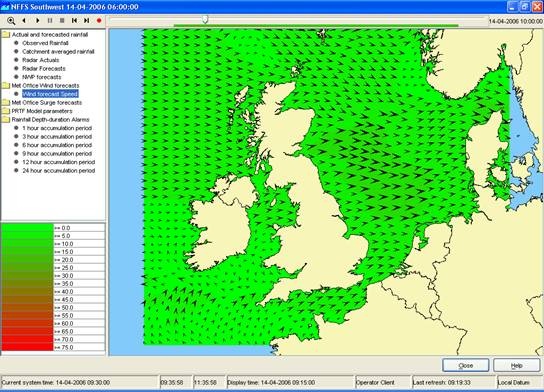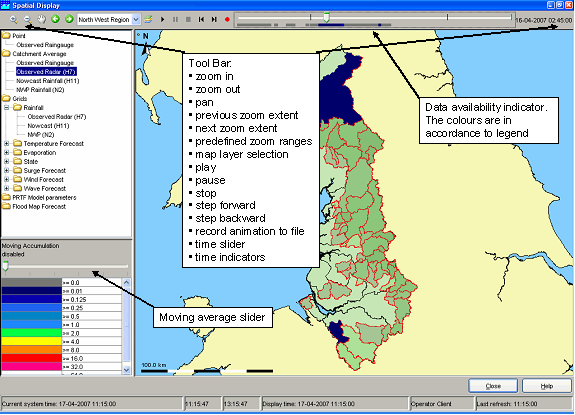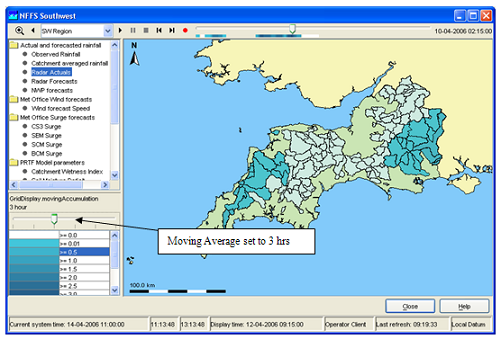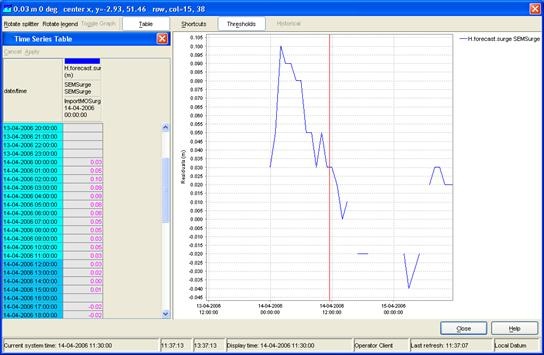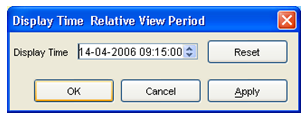Spatial Display
The Spatial Display grid display can be used to display time series of any type: scalar, polygon or grid. The display will depict the data on a map background. The display time is then set using a ruler that can be moved manually or made to move automatically.
The spatial display consists of following components:
- Spatial Display selection filters
- Control Toolbar with following options:
- Manual zoom and zoom previous buttons
- Predefined zoom range selector
- Play, pause, stop, step forward, step backward and record buttons
- Time slider with time slice indicator
- Data availability and maximum value indicator
- Moving average slider
- Legend
- Contours button
- Export time step data in ascii grid-file
Grid display selection filters
The selection filters show which displays have been configured. Select a filter to display the data. Note that each grid display may be configured differently, i.e. with a different period of data to be displayed, with a different background map, etc. The configuration allows filters to be highlighted in bold.
Control Toolbar
The toolbar provides the controls for displaying the spatial information via through the following buttons:
Button |
Description |
|---|---|
|
Play. Starts continuous play mode. The slider will indicate the time slice being shown. |
|
Pause. Stops continuous play mode. The time slider remains at the time displayed at the moment. |
|
Stop. Stops continuous play mode. The time reverts back to the start time. |
|
Step backwards. Moves the time slider back one timestep. |
|
Step forwards. Moves the time slider forwards one timestep. |
|
Record. Creates an AVI movie file. After opening the file, the display will start playing from the current time position, until the stop button is clicked. |
Time slider |
The time slider can be dragged to specific time slice. |
Data availability |
The data availability indicator provides a visual cue as to where you can find data. For those times where data is available, the colour of the data availability indicator will be set to the maximum value found in the data for that time slice. |
For the functionality of the zoom buttons is referred to the FEWS Explorer section (see 2.2).
Moving Average Slider
The moving average slider can be configured to allow the user to select a number of moving average settings. Each moving average window is then recalculated for the entire period.
Legend
The legend identifies the colour used for each range of values. The range of values used for each colour can be rescaled by right clicking on the display and selecting 'Rescale Classification' from the pop-up menu. The display colours will be updated to reflect the new classification. After rescaling, the lowest and highest values in the legend will correspond to the minimum and maximum values of the data in the current zoom extent of the display (for the selected time slice). When the display is zoomed in on an area where all data points or grid cells have similar colours, rescaling can be used to see more clearly the differences in the data values.
To return to the default classification right click on the display and select 'Back To Default Classification' from the pop-up menu. When selecting a different plot, the classification always changes back to the default classification for that plot.
Contours button
To turn on/off contour lines (regular grids configured with contour lines only). Numbers appear when the animation has stopped or paused. The colors, which indicate the value remain visible.
Export time step data in ascii grid-file
By right clicking on the display, the grid data for a specific timestep can be exported in an ascii file. Select the desirable time step with the control toolbar.
Extracting scalar time series from grid
Scalar time series can be extracted from the grid by double clicking the point of interest. Depending on the type of data, which is displayed, the scalar time series will be relevant to either a point, polygon or grid cell. This can also be done in the following way. First select the point of interest either by right clicking and selecting 'Draw Point' from the pop-up menu or by left clicking. A coloured dot will be drawn to indicate the selected point. For grid data an additional green dot will be drawn to indicate the centre of the selected grid cell. Then extract the time series for the selected point either by right clicking and selecting 'Show Time Series' from the pop-up menu or by pressing the F3 key.
A series, that is extracted from a grid, is not related to a known location or polygon ID. The series will then be identified using the grid coordinates.
The graph will automatically pop up with the time series of the selected point, polygon or grid cell. When animating the grid display, a marker will move over the time series graph as well.
Note:
Make sure that you stop the grid movie before you make a time series graph, this can cause the system to slow down because multiple processes have to be executed that take a lot of processing time.
Extracting longitudinal profiles (Xsections) from a grid time series
Longitudinal profiles time series can be extracted from grid data and shown in a separate graph as well. The profile (or cross section) is defined by drawing a profile sketch. Start drawing a profile sketch either by right clicking and selecting 'Start Drawing Profile' from the pop-up menu or by Ctrl+left clicking on the desired start point for the profile. A coloured dot will be drawn to indicate the selected start point. Add additional line segments to the profile by left clicking in the display. Finish drawing by double-clicking on the desired end point for the profile. Green dots along the profile indicate which grid cells are used for the profile.
Once a profile sketch has been drawn, extract the profile either by right clicking and selecting 'Show Profile' from the pop-up menu or by pressing the F2 key. The graph of the profile will show automatically.
To extract a different profile just start drawing another profile. This will erase the previous sketch. The profile sketch can also be erased by right clicking and selecting 'Delete Sketch' from the pop-up menu.
When animating the grid, the profile follows the same animation. When animating the profile only, the grid animation remains fixed. Note that the same cross section can be reused when switching to another plot (F2 will open a new window).
Note:
Even more essential then for scalars, it is wise to pause the grid animation when dragging a cross section to be shown.
Note:
Extraction of longitudinal profiles is not available for irregular grids, points and polygons. The profile sketch will be erased when switching to one of these data types.
Note:
If longitudinal profile data is displayed in the spatial display, then there is no need to draw a profile sketch. Just press the F2 key or right click and select 'Show Profile' from the pop-up menu to show the graph of the profile.
Setting the display time
The display time in the spatial display can be changed in the standalone system only . The use is similar to the setting the display time in the data display, but with less modification possibilities.
When the display time is modified, the relative start and end times of the data to be shown are reset and the time slider is adjusted accordingly.
